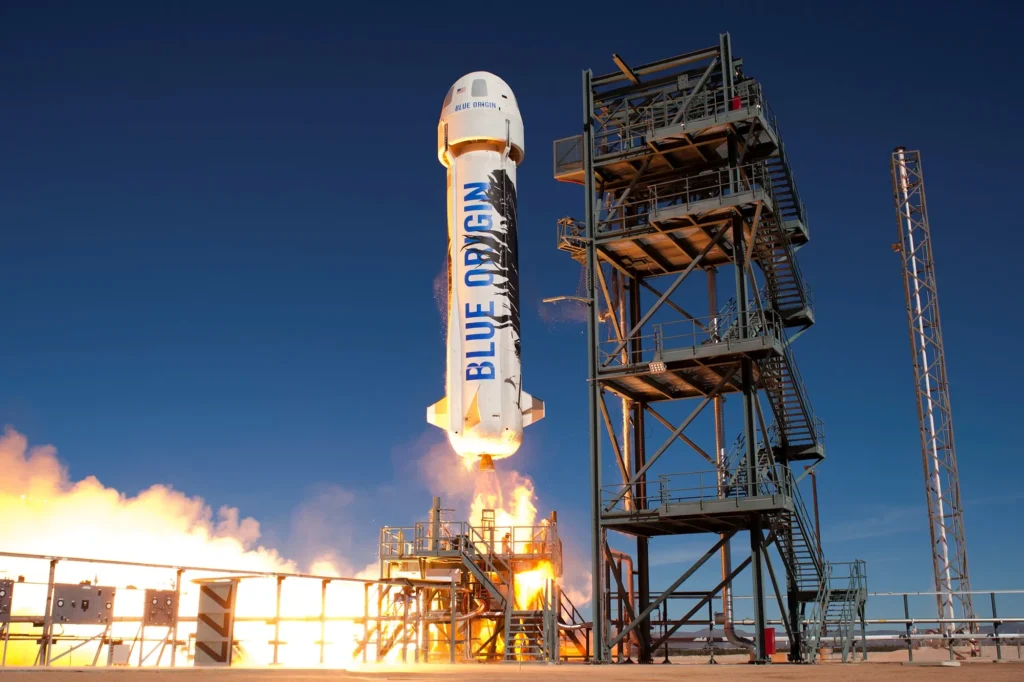Blue Origin: Jeff Bezos’ Bold Vision to Transform the Future of Space Travel (2025 Updated Long-Form Guide)

Meta Description:
Blue Origin, founded by Jeff Bezos, is revolutionizing space exploration with reusable rockets, space tourism, the New Glenn orbital rocket, and the Blue Moon lunar lander. Explore its mission, history, achievements, challenges, and future plans in this detailed 2025 guide.
- Introduction – What Exactly Is Blue Origin?
Blue Origin is an American aerospace manufacturer and spaceflight company founded by Jeff Bezos in the year 2000. Headquartered in Kent, Washington, the company’s purpose is simple yet revolutionary:
to create a future where millions of people can live and work in space.
Unlike traditional space companies, Blue Origin aims to make space travel affordable through reusable rockets, innovative propulsion systems, and long-term sustainable space infrastructure. Over the past two decades, Blue Origin has evolved from a research project to one of the most influential private space companies in the world.
In 2025, Blue Origin is finally stepping into a new era—an era where it competes globally for missions, launches, lunar contracts, and scientific deep-space programs.
- Blue Origin’s Mission, Philosophy & Long-Term Vision
Jeff Bezos often says,
“Earth is the best planet. We need to protect it by moving heavy industries to space.”
This simple idea is the foundation of Blue Origin’s mission. The company’s core vision is built around three major pillars:
2.1 Reusability as the Key to Affordable Space Travel

Blue Origin strongly believes that the biggest barrier to space access is cost. Their reusable rockets—like New Shepard and New Glenn—are designed to fly, land, and fly again.
This reduces cost dramatically and makes spaceflight far more practical for private companies and researchers.
2.2 Building Infrastructure for Future Generations
Blue Origin aims to create:
affordable space transportation
lunar landing systems
propulsion technologies
long-term habitats in space
The idea is not just to visit space—but to build in space.
2.3 Making Space Accessible for Everyone
Whether it’s astronauts, researchers, private passengers, or students—Blue Origin wants to make space reachable for all. Their motto says it all:
“Gradatim Ferociter” – Step by step, ferociously.
- Blue Origin’s Major Rocket Programs (In Depth)
Blue Origin isn’t just one rocket—it’s a full family of advanced space vehicles.
Here are the top three:
3.1 New Shepard — The Suborbital Space Tourism Rocket
New Shepard is Blue Origin’s most famous rocket, designed specifically for short trips to the edge of space.
Key Features:
Sub-orbital rocket
Fully reusable
Designed for tourists & microgravity research
Capsule carries up to six passengers
Flight time: around 11 minutes
During the flight, passengers experience:
several minutes of weightlessness
stunning views of Earth
gentle capsule landing via parachutes
In 2024–2025, New Shepard resumed crewed flights after a temporary pause, marking the return of Blue Origin’s space tourism business.
3.2 New Glenn — The Orbital Heavy-Lift Rocket

Named after astronaut John Glenn, New Glenn is Blue Origin’s answer to heavy-lift space missions.
Notable Features:
Height: Over 95 meters
Powered by BE-4 methane engines
Partially reusable first stage
Can carry satellites, cargo, and science missions to orbit
Suitable for Moon and deep-space launches
The rocket achieved its first successful orbital flight in January 2025, marking one of the biggest breakthroughs in Blue Origin’s history.
Since then, the company has been preparing for:
commercial satellite launches
NASA science missions
interplanetary payloads
government contracts
The New Glenn debut placed Blue Origin alongside the world’s leading launch providers.
3.3 Blue Moon — The Lunar Lander for Future Moon Missions
Blue Origin’s Blue Moon lander is designed to land cargo—and eventually astronauts—on the lunar surface.
Capabilities Include:
Cargo delivery to Moon
Support for lunar habitats
Transport of scientific equipment
Potential human landings in future
Blue Moon is also being prepared for NASA’s Artemis program, aiming to return humans to the Moon.
- Blue Origin’s Technological Innovations
4.1 BE-3, BE-4, and Advanced Propulsion
Blue Origin develops its own engines—something only a few companies can do.
BE-3: Used in New Shepard
BE-4: Methane engines powering New Glenn
BE-7: Designed for the Blue Moon lander
These engines power everything from sub-orbital flights to heavy lunar missions.
4.2 Reusable Rocket Architecture
With vertical takeoff and vertical landing (VTVL) systems, Blue Origin aims to fly each rocket multiple times.
This drastically reduces cost and makes space accessible.
- Major Achievements & Milestones (2021–2025)
Here are some of the company’s most important accomplishments:
✔ 2021: First Crewed New Shepard Flight (Jeff Bezos onboard)
✔ 2022: Successful reuse of New Shepard multiple times
✔ 2023: Key milestones for the BE-4 engine
✔ 2024: New Shepard returns to crewed missions
✔ 2025: New Glenn’s first orbital flight
✔ 2025: Mars mission collaboration with NASA
These milestones show Blue Origin’s transformation into a powerful force in the private space industry.
- Challenges Blue Origin Continues to Face
Even with strong progress, Blue Origin deals with:
6.1 Challenging Competition (Especially SpaceX)
SpaceX has decades of launch experience, making the competition very tough.
6.2 Technical Delays
Big rockets like New Glenn require years of testing and fabrication.
6.3 Cost Pressure
Developing reusable orbital rockets is extremely expensive.
6.4 Safety Regulations
After a New Shepard issue in 2022, Blue Origin had to complete safety upgrades before resuming flights.
Despite these challenges, Blue Origin continues improving year by year.
- The Future of Blue Origin — What’s Coming Next?
The next decade looks extremely promising.
7.1 More Frequent New Glenn Launches
With its first orbital success, Blue Origin aims to increase launch frequency to compete with global launch providers.
7.2 Expanding Space Tourism
New Shepard will fly more frequently, offering edge-of-space trips to researchers and paying passengers.
7.3 Moon Missions Through Blue Moon
Cargo delivery and future astronaut support missions are planned.
7.4 Long-Term Space Habitats & Infrastructure
Blue Origin believes that humanity must build:
factories in space
habitats orbiting Earth
sustainable lunar bases
long-term fuel production stations
7.5 Millions Living and Working in Space
The final goal is a large-scale human presence beyond Earth that protects our planet from heavy industrial impact.
- Why Blue Origin Matters in the Global Space Race
Blue Origin plays a crucial role in shaping the future of space travel.
8.1 More Competition → Better Technology
Competition pushes every company to innovate faster.
8.2 Reusability Will Lower Costs Globally
Affordable spaceflight could unlock:
better weather forecasting
faster global internet
advanced climate monitoring
new industries in orbit
8.3 Lunar and Deep-Space Support
Blue Origin’s lunar landers and heavy rockets support future space colonization and scientific exploration.
8.4 Inspiring a New Generation
Through student programs, STEM involvement, and accessible tourism, Blue Origin inspires young scientists around the world.
- Conclusion
Blue Origin started with Jeff Bezos’ dream of making space accessible to everyone. Today, in 2025, the company stands as one of the most ambitious forces in the private space industry. With rockets like New Shepard and New Glenn, and advanced projects like Blue Moon, Blue Origin is playing a major role in shaping how humanity will explore space over the next century.
From reusable rockets to lunar landers, from tourism to Mars missions—Blue Origin’s journey is only beginning.
Its advancements, innovations, and long-term vision make it a key player in building the future of space travel.


